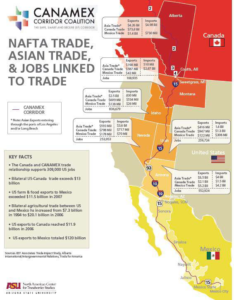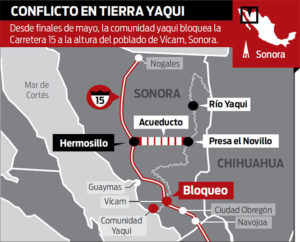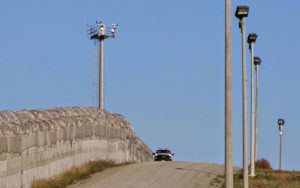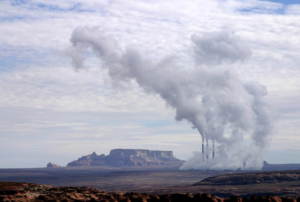The Resolution Copper land grab is also a water grab, with a projected use of millions of gallons per year and contamination of more; and during what could be a mega-drought. Water is often compared to gold as its value increases the more scarce it becomes, which means we may soon be fighting not only the increasing privatization of land, but also of water. Despite the fact that the Resolution Copper deal, having been snuck into a defense bill, involves an exchange of land, it is being done to the advantage of a transnational mining corporation and to the detriment of theChi’Chil’Ba’Goteel/Oak Flat/Apache Leap area and the people who hold it sacred. This land grab represents a continued prioritization of economic development in so-called Arizona, which means more resource-extraction and increased international trade (specifically with or through Mexico). Mining and other industries shaped by trade-related demand bring not only risk to water, but also more roads like Interstate 11 and rail (which require land acquisition), and increased border militarization. US trade policy is largely culpable for the violence on the border and south of the border.
Economic development is portrayed as bringing more jobs, but these “free-market” policies, as in the case of NAFTA, are meant to redistribute wealth to the hands of the rich. Because of their trade relationship and connecting infrastructure, Arizona and Sonora have a shared fate as land, water, safety, indigenous ways of life and sacred sites are all at risk. The state governments enable resource-extraction and other infrastructural projects, lucrative to those who would build them and those who would finance them, through subsidization and protection with our tax dollars.
Arizona’s connection to a port in Guaymas, Sonora is crucial to the Arizona mining industry. Copper is one of the fastest growing US exports, and much of what is and would be mined in Arizona would be transported down to where mining companies such as BHP Billiton (of Resolution Copper) and Freeport McMoran dobusiness at this Mexican port on the Sea of Cortez. Guaymas is also significant because shipping companies can have lower standards for working conditions in Mexico versus the US. This port is the southernmost point of the CANAMEX Corridor, the NAFTA trade route connecting Canada and Mexico through five US states including Arizona. The Port of Guaymas has been expanding over the years and brings along its own set of problems in the vicinity, requiring its own energy sources and water, damaging the environment, impacting the local communities, etc. Arizona is counting on the continued growth of the Mexican economy, yet the importance of the Port of Guaymas also signifies that a lot of exports from the US are meant to cross the Pacific ocean (especially if the Trans Pacific Partnership goes into effect), not stay within its favored trade partner’s borders.
The CANAMEX Corridor already exists, but will be considered complete once Interstate 11, which is in the study phase (aside from the Boulder City Bypass which is scheduled to break ground this year) has been constructed, connecting Las Vegas and Phoenix with a route fit for freight traffic.Interstate 11 may eventually refer to the entire trade corridor reaching from Mexico to Canada, or at least is intended to span from the Mexican border and beyond Las Vegas. Parts of it maybe multi-modal including rail and other infrastructure possibly including water pipeline. This massive project will cut through communities and damage the environment. Conceptualized as the entire trade corridor, it is currently also referred to as the Intermountain West Corridor–basically CANAMEX but with a more updated, more western route where it would run north of Las Vegas. South of the border, the Mexican government has recently agreed to the request by Arizona officials to improve Route 15, which is part of this Corridor, for freight traffic.
Intermittent blockades of Route 15 have been one tactic used by Yaqui resisters in response to the theft of their water in the last few years. The rapid growth of the City of Hermosillo in the state of Sonora, Mexico situated along the CANAMEX Corridor, on the way to the Port of Guaymas, is due in part to NAFTA-fueled agribusiness and mining which are the primary water-users. As it is, Sonora essentially exports millions of gallons of fresh water to the US in the form of fruits and vegetables. In the context of the drought and overuse of water, and as a result of the ways international trade has impacted Sonora, Hermosillo has required acquisition of water, impactingthe Yaquis, Mayos, and Guajiríos with aqueducts and dams on the rivers. These mega-projects, enacted by Sonora SI (started by the Sonoran Governor who has a close relationship with the mining industry), have the intention of addressing the water crisis (for Hermosillo), contributing to the competitiveness of the region and providing new infrastructural projects for companies to make money from.
Since technology is now allowing for relatively affordable removal of salt from the plentiful ocean water, one megaproject planned for Sonora is one or more desalination plants. It is possible that theAgreement of Cooperation between the states of Arizona and Sonora signed by the respective governors at the Arizona-Mexico Commission’s Plenary Session last summer to jointly evaluate the feasibility of desalination at the Sea of Cortez for a new water supply for Arizona and Sonora is related to the Sonora SI project, which includes a desal plant in San Carlos near Guaymas. The potential for desalinated water piped from California or Mexico is part of Arizona’s official water strategy. This year, a bill is in the Arizona House of Representatives to fund and arrange a study for the potential for desalination for Arizona. The intention for Arizona to expand and become more competitive in trade, along with potential new copper mine(s) will mean new demand for water, and with the combination of scarcity and new infrastructure, the water could be privatized. Desalination plants threaten the environment in various ways including the direct impact on their location on the water, as well as through the use of energy in the process and transport of the water.
Despite the likely need for drastic measures even if Arizona doesn’t grow, some in Arizona find that expansion is necessary and inevitable. A so-called “megapolitan” area including Phoenix and Tucson called the “Sun Corridor” is intended as an economically integrated trade hub along the CANAMEX Corridor. Those interested in this concept have been attempting to reform state trust land law in the interest of further growth and development. The Sun Corridor concept is supposedly justified by—at the same time as it is used to encourage—growth and accompanying infrastructure especially for freight traffic in the area despite that growth is not sustainable in the area. The infrastructure required includes new roads, rail, ports, and border security.
Along with the steps to build Interstate 11, just in the last few months, Arizona opened trade offices in Hermosillo and Mexico City, committed funding to increase freight rail infrastructure near the border and to expand ports of entry at the AZ/Mexico border. According to ADOT’s press release, Arizona was involved in a US/Mexico joint investment “implementing U.S. technology, equipment and training to enhance the efficiency of the military inspection station north of Hermosillo,” which involves $6.8 million almost certainly from the Mérida Initiative, with an additional $4 million from the Mexican Government.
The primary intention of the Mérida Initiative (also known as Plan Mexico, a reference to the failed Plan Columbia) is supposedly to fight the drug trade, but one major role, to create a “21st Century Border Structure,” deals with trade and migration as well. This is meant to “Facilitate legitimate commerce and movement of people while curtailing the illicit flow of drugs, people, arms, and cash. The Mérida Initiative will provide the foundation for better infrastructure and technology to strengthen and modernize border security at northern and southern land crossings, ports, and airports.” Sure, the US wants to prevent the illicit activity that correlates with increased movement of trucks across the border. It is also the trade policies themselves, and the accompanying poverty and displacement, that contribute to migration (and arguably contribute to the drug trade). Many in US benefit from exploiting the cheap labor created by criminalization of migrants. And then there are the security and technology companies who can profit from infrastructure and equipment involved in securing the border. Large transnational companies such as Israeli company Elbit Systems brings their similar experience in militarizing the Gaza Strip and enforcing their apartheid wall to the border as well. The potential for any future Comprehensive Immigration Reform to bring about a “border surge” manifesting a massive profit-making opportunity for the military industrial complex to the US/Mexico border will likely make it even worse than it already is. Migrants continue to die crossing the border. Tohono O’odham who live along the border or visit relatives also face daily harassment, abuse, check-points, invasion of privacy, limits on movement, drones, cameras, etc. due to the border patrol’s activities where the border bisects their lands.
Arizona officials and business leaders want to believe the myth that Mexico has the violence and organized crime under control. In the interest of becoming more friendly to international investment, for just a few years prior to the violent disappearance of the students from Ayotzinapa in late 2014, Mexico attempted to make itself look as though it was successfully instituting the rule of law. Yet law enforcement is clearly involved in much of this violence. And U.S. trade policy is largely culpable. Many violent acts tend to be depoliticized and obscured by associating the victims with drugs. Students at the Normal school in Ayotzinapa were known for protesting neoliberal reforms in Mexico. The fact that they were clearly not involved with the drug trade and that it involved so many youths made what happened to them more worthy of media attention.
The drug war, instead of curtailing the production and movement of drugs, functions, even if not specifically intended to, to facilitate resource-extraction and international investment in areas such as Mexico and Central America. Militarization and paramilitarization benefit US and transnational corporations’ involvement there through displacement and social control, as described in Dawn Paley’s new book, “Drug War Capitalism.” With at least a couple dozen mining conflicts in Mexicoalone, and the violence faced by activists who oppose mining, it is clear that even when organized crime groups are involved in law enforcement and violence, these are often acts of repression. For mining to continue, people are forcibly displaced, and the state facilitates this, in part by US tax dollars and to a certain extent for Arizona trade interests. Mining companies around the world often have arrangements with paramilitaries and/or military to protect them, such as in the cases of Resolution Copper’s BHP Billiton in Columbia, and Phoenix-based Freeport McMoran in Indonesia.
In modern history in Arizona, displacement looks different but is no less significant. Confiscation of livestock, used as a tactic of attrition to force Diné who have resisted displacement from their lands so Peabody Coal can continue strip-mining the Black Mesa area, has occurred as recently as October 2014. Somemembers of Congress have recently urged that the relocation project be completed. Arizona’s urban areas’ access to water and electricity involves a mega-project that has a complex history few know about, which is all the more relevant in relation to the Yaqui water struggle and the potentiality of infrastructure being built for desalinated water. Often characterized as savvy and industrious, the efforts made to create the Central Arizona Project (CAP) that brings water from the Colorado River, and the whole project including Peabody Coal’s strip-mining (to fuel the generating plant that powers CAP and provides electricity to Phoenix, Las Vegas and other areas), rests on a history involving manipulation, manufactured conflict between the Diné and Hopi and among tribal members, forced removal of families, contamination and depletion of water, and the poisoning of those who have lived close to the mines and the generating station.
Indigenous people’s access to clean and plentiful water has been threatened since settlers arrived, even after they were given priority water rights by the federal government. Not only did Southern Arizona settlers divert water away from sources Tohono O’odham and other indigenous people relied upon, and contributed to erosion of their lands, indigenous people have been swindled for their priority water rights over the the last several decades. The Arizona Department of Water Resources considers the resolution of tribal water rights claims (9 more out of 22 total) the number one priority due to the uncertainty of long-term water availability for Arizona. Often the settlements promise infrastructure to provide water delivered to homes on the reservations, instead of addressing the root causes of poverty and lack of access to clean water. The mining industry consumes and contaminates water on a massive scale, and because of how much water it depends on, is especially interested in securing water rights at the expense of priority water rights held by some tribes in Arizona, such as in the case of Freeport McMoran being involved in the settlement of Hualapai water rights claims last year.
 In some cases, mining companies like Freeport McMoran have been buying land for the associated water rights. Freeport and Resolution Copper have benefited from legislation and/or legal exemptions that allow them to essentially hoard water. No doubt the Resolution Copper mine near Superior would use several millions of gallons of water a year. Rio Tinto (of Resolution Copper) haspurchased future water rights from CAP. The risk to water in AZ will be compounded if the Rosemont Copper mine near Tucson also gets approved. Access to clean water that is also affordable becomes a grave concern as water becomes scarce, commodified, and potentially privatized as more infrastructure is involved in its acquisition and treatment.
In some cases, mining companies like Freeport McMoran have been buying land for the associated water rights. Freeport and Resolution Copper have benefited from legislation and/or legal exemptions that allow them to essentially hoard water. No doubt the Resolution Copper mine near Superior would use several millions of gallons of water a year. Rio Tinto (of Resolution Copper) haspurchased future water rights from CAP. The risk to water in AZ will be compounded if the Rosemont Copper mine near Tucson also gets approved. Access to clean water that is also affordable becomes a grave concern as water becomes scarce, commodified, and potentially privatized as more infrastructure is involved in its acquisition and treatment.
As is implied in “There is No Drought: California’s Twisted Waterways,” the threat of a serious drought can be used by those interested in profiting off the scarcity of water, and the “solutions” which are proposed are those that benefit these private interests. Obama made water privatization in the US easier, when on June 13 of 2014, he signed the Water Resources Reform and Development Act (WRRDA) into law. This included the Water Infrastructure Finance and Innovation Authority (WIFIA) which is a 5-year pilot program providing financing for P3s for water projects. WIFIA, mirroring the “Transportation Infrastructure Finance and Innovation Act” (TIFIA), was a concept developed and promoted by the American Water Works Association (AWWA). The new director of the Arizona Department of Water Resources was a member of the AWWA.
Additionally, various companies involved in other Arizona infrastructural projects (AECOM, CH2MHill, CDM Smith, Bechtel) are involved in water privatization across the world.AWWA, a non-profit, is supported by CH2MHILL and closely affiliated with AECOM. And with more P3s for transportation, the likelihood for P3s for water increases.
Private interests have pushed for Interstate 11 due to its role in trade. I-11 is also likely to be procured as a public-private partnership (or several). Public-private partnerships (P3), a type of arrangement which we’ll be seeing more of in the coming years (and is in the works for the South Mountain Freeway), are proposed as a mutually-beneficial solution that uses complicated financial strategies to leverage state assets and essentially provide federal and/or state subsidies (through tax-free bonds, low-interest loans, etc.) to the private sector. It helps finance projects for which funding is otherwise lacking—therefore it is a much desired arrangement for construction and engineering companies, consultants, as well as banks. The P3 creates new profit opportunities for financial institutions, in the meantime creating more debt, and therefore it is largely about financialization. A P3 can also be understood as a form of privatization, not because a P3-built road would not be publicly accessible, but because P3s afford private entities influence, agency, and financial deals they would otherwise not have access to. Projects such as roads are more likely prioritized based on the interest of private parties, and based on what is incentivized by the federal government. A public-private partnership could also refer to an organization (“P3 unit”) that involves public officials and private members, creating new forms of governance that provide opportunities for private involvement in decision-making.
Two such P3 units of note in Arizona are the Arizona-Mexico Commission (AMC) and the Transportation and Trade Corridor Alliance (TTCA). Both of these organizations involve the Director of the Arizona Department of Transportation and other state officials as well as various corporate leaders, with much overlap between the two. The pro-NAFTA AMC, who takes credit for pushing CANAMEX along, seems to have had a lot to do with getting TTCA instituted and becoming a major influence in Arizona policy on trade and transportation in recent years. Freeport McMoran has been a major sponsor of AMC and has had someone on the board of directors for several years. The locations of Freeport’s Arizona mines and their use of the Port of Guaymas correlates with their interest in CANAMEX and I-11. Freeport hired the last director of the Arizona Department of Water Resources as their water strategist, and this department now has an intimate relationship with AMC, even listing AMC
It is no surprise as well that Senator John McCain has been a large proponent of the land swap for Resolution Copper, the Mérida Initiative, increased trade with Mexico, and the TPP. But this goes far beyond him and the AMC. Across the world, the World Bank and IMF have coerced countries into adopting structural adjustment programs or other changes in exchange for access to loans. We may be aware of austerity measures in the US, but we may not realize the various ways in which Arizona (or other US states for that matter) is also impacted by state-enabled free market ideology even as the state is not forced into formal agreements to open new areas up to private “partners.” The economic development, made to seem intended to create jobs and improve the livelihoods of citizens is about nothing more than accumulation of wealth. It is clear though, that whether we call it neoliberalism, capitalism, or colonialism, is also a project of the state.
Fight Back:



